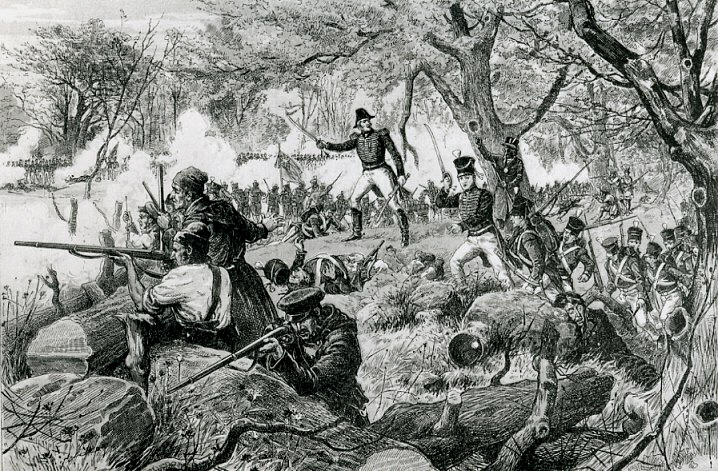1813 Battle of the Chateauguay
 In the autumn of 1813 the United States launched a two-pronged attack on the city of Montreal, hoping to control the St Lawrence River valley and end the British military control of Lower Canada. On this date, one of those columns under Major General Wade Hampton met defeat at the Battle of the Chateauguay.
In the autumn of 1813 the United States launched a two-pronged attack on the city of Montreal, hoping to control the St Lawrence River valley and end the British military control of Lower Canada. On this date, one of those columns under Major General Wade Hampton met defeat at the Battle of the Chateauguay.
Hampton was an experienced officer, a veteran of battles in the Revolutionary War and against a slave uprising; by 1813 he was one of the most senior generals in the American army. His orders were to lead a force of about 4,000 regulars and militia men from Lake Champlain, strike into Quebec and rendezvous with another column outside of Montreal. This plan suffered number of setbacks, not the least of which was the refusal of 1,400 New York militia to cross the border. To add to the confusion, his orders were countermanded by the American Secretary of War after his troops had been committed to battle, and local guides (either deliberately or mistakenly) gave unreliable advice stranding hundreds of his men in a forest. On October 26 Hampton’s main force encountered British, Canadian, and Mohawk units at a ford on the Chateauguay River.
The troops facing the American invasion were a curious mixture of British regulars, Quebec volunteers, other locals drafted for a year’s military service, and Mohawk warriors from Kahnawake. They were commanded by a Canadian colonel, Charles de Salaberry, a seigneur who had seen long service with the British army in the West Indies and in the Netherlands in the wars against Napoleon. In 1803 he killed a fellow officer in a duel.
Salaberry’s men were greatly outnumbered and possessed no artillery to counter the 10 American cannon but they had better intelligence of their foe’s movements and were well-entrenched. Unable to outflank the Canadians and unwilling to risk heavier casualties in a frontal attack, Hampton decided to withdraw. His retreat, and the defeat of the other American column at the Battle of Crysler’s Farm, meant an end to that year’s threat to Montreal.
Hampton retired shortly after the battle and returned to his South Carolina plantations where he was an owner of thousands of slaves. Salaberry became a folk hero in Quebec and was made a Companion of the Order of the Bath by the British government.